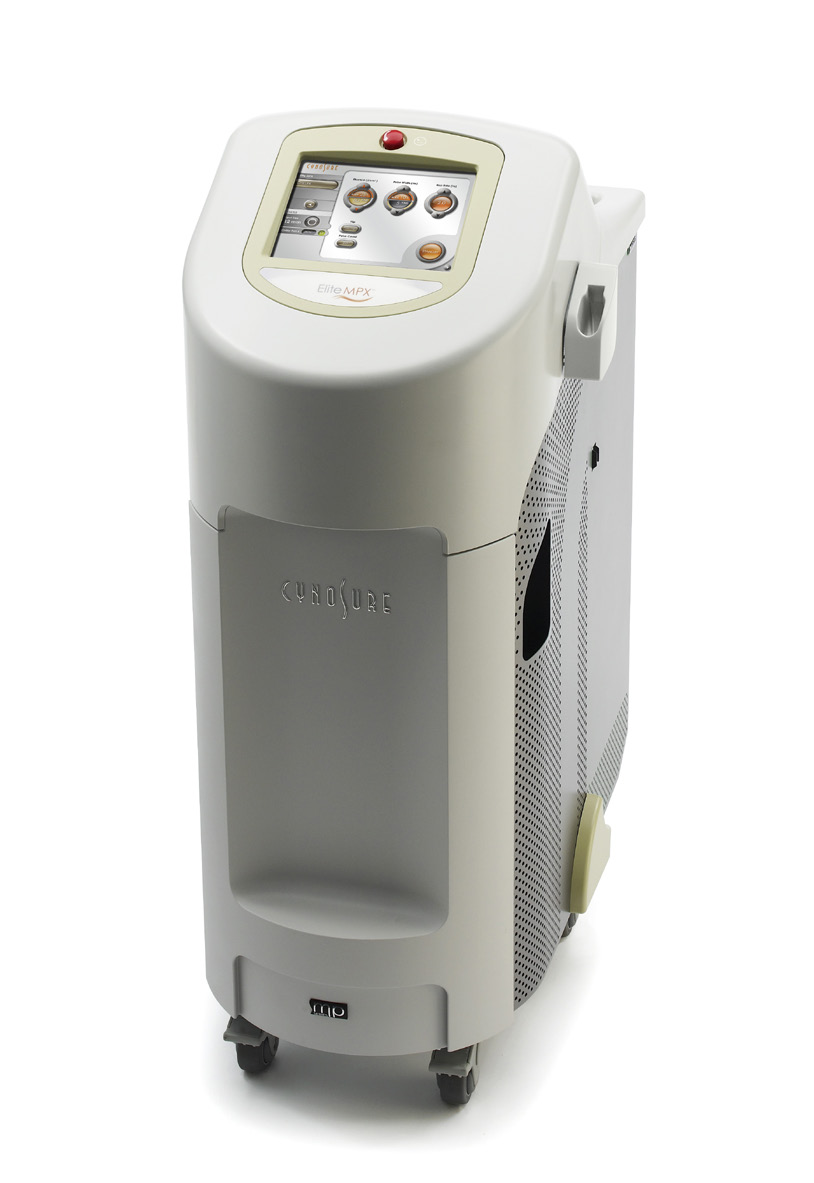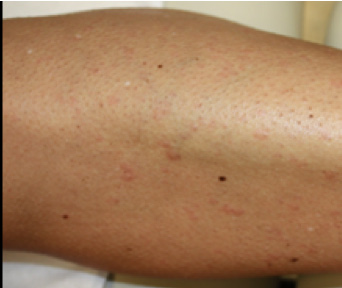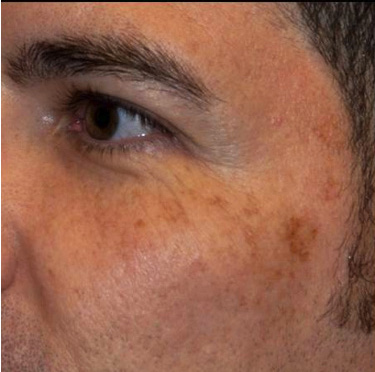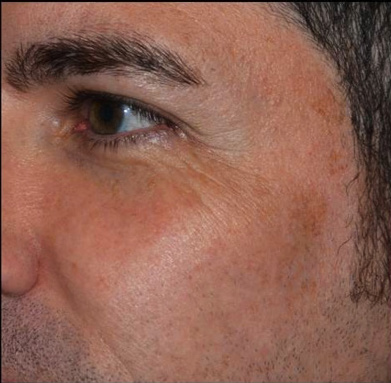Cynosure.de

White Paper
Elite MPXTM for the Treatment of Solar
Lentigines and Pigmentation
Raminder Saluja, MD
Saluja Cosmetic and Laser Center (SCLC)
SUMMARY
As laser technology continues to advance, physicians have choices regarding wavelengths, spot
sizes and pulse durations that can effectively target a specific chromophore while respecting the
surrounding epithelium in darker skin types. These advances allow for more efficient eradication of
chromophores, such as melanin, with less downtime.
The safety and efficacy of the long-pulsed
The Elite MPX laser (Cynosure, Westford, MA)
Alexandrite laser for treating solar lentigines
has been a gold standard platform for laser hair
has been reported.1 Thus, for patients with
removal. With the dual-wavelength delivery of
more diffuse dyschromia, or with greater areas
the 1064nm Nd:YAG wavelength and the 755nm
of solar lentigines, the long-pulsed Alexandrite
Alexandrite wavelength, clinicians can titrate the
laser may present a useful and effective
percentage of each, and modify pulse durations
alternative to the Q-Switched laser for
to provide the most effective and safe destruction
pigment reduction.
of the hair follicle. However, the applications of Elite MPX are greater than hair removal alone. By utilizing the additional intense pulsed light (IPL) component, and isolating the Alexandrite wavelength in different spot sizes, the clinician is armed with a powerful solution to address both diffuse pigmentation and discreet melanin.
MELANIN
Melanin production occurs in the basal layer
of the skin in response to UV stimulation. The
absorption curve of melanin has a gradual slope;
therefore, there is no single "best" wavelength
for targeting this chromophore. However,
shorter wavelengths within the blue spectrum
or the green/yellow spectrum will be absorbed
better than longer wavelengths. Balancing
the wavelength, spot-size, and pulse duration
parameters will allow the clinician to target the
cosmetically concerning pigmentation.
THE ELITE MPX LASER
Elite MPX is a dual-wavelength, sequentially
heard, and the lentigo took on a rough, textural,
emitting laser consisting of both the Alexandrite
darkened appearance. The patient described his
and the Nd:YAG wavelengths. These wavelengths
discomfort as 2 out of 10 for both the IPL and the
can be fired sequentially or singularly in a wide
Alexandrite laser on the visual analog scale. The
array of spot sizes ranging from 3mm to18mm.
patient followed up six weeks post the first laser
Versatility is further increased by the IPL component.
treatment and was happy with the results post one treatment.
The IPL can be used to treat generalized
dyschromia, while the Alexandrite wavelength
A 36-year-old white female with Fitzpatrick skin type
can target discreet solar lentigines, which will
III presented to our office because of solar lentigines
audibly "pop" when treated at a 5 Hz repetition
on her legs. She was bothered by their appearance
rate. The melanin will immediately darken,
and felt self-conscious of the pigmentation when
and appear elevated and textural as a result.
wearing skirts or dresses.
Perilesional erythema and slight edema may persist for up to 24 hours. Patients are instructed
Upon examination, her lesions appeared discreet
to use sun protection and to wash normally and
with no surrounding pigmentation, so the Alexandrite
not exfoliate the treated areas. The darkened
laser was selected to target the lesions. As before, no
lentigines will typically flake off within 10-14
topical numbing was applied, and the integrated
days. If a second treatment is needed, it is
SmartCool air cooling system was set at 2. Fluence
typically scheduled 4-6 weeks post initial treatment.
was increased until the popping sound and change in texture and color was noted. Mild perilesional
erythema and edema developed, then resolved
A 38-year-old male with Fitzpatrick skin type III
after six hours. The patient did very well post one
presented to our clinic with solar lentigines on
treatment with nearly 100% clearance of her lesions.
the left side of his face. He reported currently using sunscreen with SPF of 30 or higher, but did
not use as a child. He had not previously been
A 42-year-old female with Fitzpatrick skin type III
treated with tretinoin or hydroquinone. He was
and solar lentigines of the décolletage presented
interested in exploring laser and light-based
to our clinic. She had used a combination of tretinoin
options to treat his area of concern.
and hydroquinone 4% in the past, but felt that
During consultation, the patient was informed
the pigmentation was only minimally lightened
that 2-3 treatments may be needed every
by this combination. She wanted to explore other
4-6 weeks. No topical numbing was applied
treatment options.
to the skin. The 560nm filter IPL was used first to
The discrete nature of her solar lentigines correlated
address diffuse pigmentation. The fluence was
well to the efficacy of the Alexandrite wavelength
increased until the pigmentation darkened and
alone. She was treated using the Alexandrite laser
mild erythema developed. Once the integrated
with a fluence of 16 J/cm2. The patient did very well
SmartCool air cooling system was set at a low
post one laser treatment.
level of 3, treatment with the Alexandrite laser began at a fluence of 16 J/cm2 and a 5mm spot size. The pulse duration was shortened to 0.5ms and the repetition rate was increased to 5 Hz. An audible "popping" noise could be







Subject 1
6 weeks post 1 Tx
IPL 560nm
13 J/cm2
755nm
5mm spot size
16 J/cm2
0.5ms
5 Hz
Subject 2
6 weeks post 1 Tx
755nm
5mm spot size
16 J/cm2
0.5ms
5 Hz
Subject 3
3 months post 1 Tx
755nm
5mm spot size
18 J/cm2
5 Hz
Solar lentigines and generalized dyschromia
1. Rosenbach A, Lee SJ, Johr RH. Treatment
can be treated with a variety of different
of medium brown solar lentigines using an
laser and light sources.2,3 The primary class
Alexandrite laser designed for hair reduction.
of lasers for treating melanin has been the
Arch Dermatol 2002. 138:547-8.
Q-Switched laser, which can induce instant melanocyte destruction, but may damage
2. Rosenback A, William CW, Alster TS.
normally pigmented epidermis in some patients.
Comparison of the Q-Switched Alexandrite
Conversely, a long-pulsed Alexandrite laser
(755nm) and Q-Switched Nd:YAG (1064nm)
gently heats the melanin and is less spatially
lasers in the treatment of benign melanocytic
selective, so broader areas of pigmentation
nevi. Dermatol Surg 1997; 23: 239-44.
can be treated quickly and safely.3
3. Traeli J, Kwan JM, Meehan KJ, Domankivitz Y,
The combination of IPL and long-pulsed
Gilbert S, Malomo K, Ross EV. Use of a long-
Alexandrite together can aid in pigment
pulsed Alexandrite laser in the treatment of
lightening with better yields still. The IPL is
superficial pigmented lesions. Dermatol Surg
used first for dyschromia, followed by discrete
treatment of the solar lentigines with the Alexandrite wavelength. Both the IPL and the Alexandrite laser are found in Elite MPX, thus providing safe and effective treatment for pigmentation.
2013 Cynosure, Inc. Cynosure is a registered trademark of Cynosure, Inc. Elite MPX is a trademark of Cynosure, Inc. 921-0443-000 Rev.1 05/13
Source: http://cynosure.de/wp-content/uploads/2013/06/921-0443-000_r1_EliteMPX_Treatment_of_Solar_Lentigines_pigmentation_HR.pdf
Sociedad de Agricultores Unidos de la República Oriental del Uruguay Fundada en 1901, con Personería Jurídica DIZIRAM 76 WG 1. IDENTIFICACIÓN DE LA SUSTANCIA Ojos: Enjuagar inmediatamente los ojos con agua limpia durante al menos 15 minutos y obtenga ayuda medica. Nombre producto: Ziriam 76 PCT WDG Ingestión: Lavar la boca con agua. No induzca el vómito. Mante-
Journal of Advancement in Medicine Volume 8, Number 2, Summer 1995 The Basis for Microcurrent Electrical Therapy in Conventional Medical Practice Joseph M. Mercola, DO and Daniel L Kirsch, PhD, DAAPM The use of electricity in medicine is not new. Clinicians used it over 150 years ago to treat non-union bone fractures. Electomedicine and nutrition, abandoned early in this century, have been recently revived. Most physicians are unaware of their therapeutic benefits. Electrotherapy, especiaily microcurrent electrical therapy (MET) is usefil for a variety of clinical conditions. Indeed, it may be the best treatment for many pain-related disorders, providing fast relief of symptoms and quickly promoting healing. It has significantly less side effects than drugs in chronic conditions. The more advanced MET devices can often demonstrate effectiveness with a simple two minute office procedure, allowing validity to be quickly assessed.









